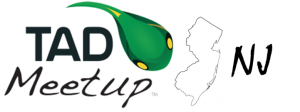 Firstly, a big thank you to Jim Machi, Vince Puglia, Robin Carley and the rest of the Dialogic team for providing the meeting venue, great demos, coffee, cookies, soda and pizza 🙂 You made TADMeetupNJ a great event.
Firstly, a big thank you to Jim Machi, Vince Puglia, Robin Carley and the rest of the Dialogic team for providing the meeting venue, great demos, coffee, cookies, soda and pizza 🙂 You made TADMeetupNJ a great event.
We had another packed event with over 25 people, this time including some telcos: Tata Communications and a recent ex-Verizon person (so counts as half). We’re slowly making progress with TADMeetupNJ in representing the telco industry in NJ. And a shout out to Tata Communications for recognizing what we are doing in sending two people who made an excellent contribution to the discussion. And also sending props to Moshe, Aron and David who came all the way from NYC and Brooklyn through the hellish metro area rush-hour traffic.
This previous weblog discusses the agenda which focused on a TADHack / TADSummit update and a number of demos covering WebRTC and mobile sports content.
Update on TADHack and TADSummit
I gave a quick review of TADHack, highlighting the importance of WebRTC as a gateway technology for broader adoption of telecom APIs amongst developers. Team diversity was important to winning, that is including product and user experience people to deliver compelling hacks. For TADSummit I reviewed the event we’re putting together, sharing the keynotes, telco case studies, and work streams:
- Work Stream 1. Go-to-market challenges for Enterprise Services.
- Work Stream 2. How can Telco and Vendor Innovation Ecosystems work together?
- Work Stream 3. Managing Intellectual Property Rights for Service Innovation.
- Work Stream 4. Innovation in legacy consumer services.
- Work Stream 5. Processes for successful new service commercialization.
- Work Stream 6. How can TADHack deliver a service innovation pipeline?
Deep Contexting with WebRTC by Aswath Kajana
Context is King! For any communication there is a pre-condition, a need, a context. Whether its finding out about a specific product, resolving a problem, reviewing a document, asking a question on eligibility, etc. Context not only makes the interaction more effective, but also fundamentally changes the communications model. WebRTC and the HTTP URI enables context to be shared using technology available in most computing platforms. You can see Aswath’s TADHack submission on Deep Contexting below.
2. myVirtualLesson (TADHack winner)
Vince showed the hack he put together for TADHack, using Tropo (text to speech), WebRTC and Dialogic for the media processing to deliver golf lessons online, his TADHack pitch is shown below. It gave everyone a chance to chat about his implementation experience, why he made particular technology choices, and of course discuss all the additional features and capabilities that can be added to the hack.
3. Flexible Multi-party UI with a WebRTC MCU
You can see more info on this demo in this weblog. In this demo Dialogic’s PowerMedia XMS optimizes performance by mixing all parties into a single, synchronized downstream to limit client bandwidth and processing requirements. This is optimal but not flexible as each client receiving the downstream is exactly same layout including their own reflection stream.
Dialogic partnered with Priologic the creator of the popular open-source EasyRTC node.js-based WebRTC platform to create a special EasyRTC JavaScript client that uses the HTML5 canvas to decompose this single multi-party stream into individual attendees on the client-side, giving the UX developer complete control over how each participant is shown. So each client has the flexibility to modify how the downstream video is viewed as they wish.
Again much discussion ensued on the application, benefits and the importance such functionality will play in the emerging cloud communications space. This topic will be explored more Cloud Communications stream at the IIT RTC Conference in Chicago 30 September to 2 October.
4. Kiswe Mobile demo of “Mystics Live” interactive sports experiences
And finally Kiswe Mobile showed a powerful interactive live sports content application, available in the app store, that has solved a similar problem to the MCU demo in processing media in the cloud for best quality personalized viewing. Even though Francis made clear this is not a ‘telecom app’ it was using media processing in the network / cloud. So was a great complement to previous demos, and highlighted the convergence between web and telecom applications, where value is created through an entity in the middle given the real world access limitations that will not disappear anytime soon. Kiswe are expanding and looking for javascript app developers, Android and iOS app developers and mobile platform developers in the NJ area.
On the TADMeetupNJ message board we’re having a discussion on the next date, agenda and location of the next TADMeetupNJ so join in if you’d like to give a demo, lead a discussion topic, propose a work item, or simply update the group on a relevant topic, e.g. Carl Ford will be giving an update on his PSAP (Public-Safety Answering Point) initiative.
In addition to discussion on the demos the meetup provides an opportunity for networking, general discussion, and sharing of perspectives on the latest announcements and gossip in a friendly and frank environment without any of the big company politics or marketing double speak.